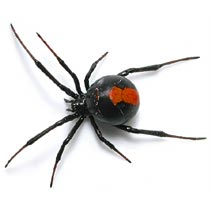Spiders

There are many different types of spiders that live all over the Earth in practically every type of habitat. They come in colors including black, brown, white, gray, red, yellow, green, and orange. Most spiders live for about a year, but the tarantula can live for 15 years. Spiders range in size from barely visible to many centimetres across.
Spiders are arachnids (and not insects); they are related to scorpions and ticks. Young spiders are often cannibals (they will eat each other), and females often eat the male after mating. Spiders are carnivores (meat-eaters); most eat insects (like moths and crickets), but the larger spiders, like tarantulas, will eat many other small animals
Arachnid (spiders) have an exoskeleton, a two-part segmented body, and 8 jointed legs. They do not have a backbone. The body is divided into the prosoma and the abdomen. The prosoma anchors the chelicerae (pincers), pedipalps (mouth parts) and four pairs of legs.
Arachnid are aggressive predators. They are cold-blooded; their body temperature depends on the temperature of their environment. Arachnids breathe air through book-lungs, gill-like structures.
Food
Spiders are predators that eat various other arthropods, usually smaller than themselves. Common prey include crickets, flies, bees, grasshoppers, moths and butterflies.
Habitat
If a web builder, the nest is usually near where insects will fly, for example, near flowers or moist areas. Some web spinners build their nest on the ground to catch walking insects and arthropods. A retreat area may be just off the web in a crevice, rolled leaf, or twig. Species that burrow into soil may situate nests under a log, rock or in a crevice. The jumping spiders do not make webs, but actively hunt for prey.
Predators
Some wasps, other spiders, birds and lizards prey on spiders.
Where to find
Spiders build webs in shrubs, trees, along rock walls, storage rooms and in corners. Many spiders live in a retreat area off the web. Burrowing spiders may be found under rocks, logs, in debris or old litter. Be cautious of black widow spiders whose webs are strong and sticky. If they are in your area they are common in storage areas, under plants and under sheets of wood or cardboard.
Spiders recognized as dangerous include true funnel-web spiders, the redback and brown widow spiders, and the mouse spiders.
Treating bites by Australian spiders
In June 2000 the only anti-venoms available for treatment of victims of spider bites are those specific for the redback and funnel-web species, although there is some evidence that the funnel-web anti-venom is effective against the venom of the male eastern mouse spider and the redback anti-venom also benefits victims of brown widow spider bite.
Most dangerous Australian spiders cause their harmful effects on the human body by interfering with the functioning of the nervous system, but the white-tailed spider has long been accused of causing a very different kind of injury. Its venom may be capable of causing necrotising arachnidism, the characteristics of which are an area of inflamed and often ulcerated skin that can continue to enlarge for many weeks and that is generally unresponsive to antibiotics and antiinflammatory agents, although it may sometimes be resolved by hyperbaric oxygen therapy.
Depending on the species of spider, our licensed pest controllers can assist you with a solution to meet your needs in your home or workplace. Call now for free advice.

